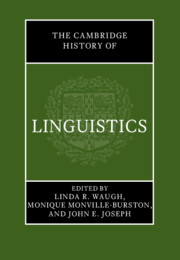Book contents
- The Cambridge History of Linguistics
- The Cambridge History of Linguistics
- Copyright page
- Dedication
- Contents
- Figures
- Tables
- Contributors
- Preface
- Acknowledgments
- Abbreviations, Acronyms, Special Symbols, and Other Conventions
- Introduction
- Part I Ancient, Classical, and Medieval Periods
- Part II Renaissance to Late Nineteenth Century
- Part III Late Nineteenth-through Twentieth-Century Linguistics
- Part IIIA Late Nineteenth Century through the 1950s: Synchrony, Autonomy, and Structuralism
- 13 Move to Synchrony: Late Nineteenth to Early Twentieth Century
- 14 Structuralism in Europe
- 15 British Linguistics
- 16 American Linguistics to 1960: Science, Data, Method
- Part IIIB 1960–2000: Formalism, Cognitivism, Language Use and Function, Interdisciplinarity
- References
- Index
14 - Structuralism in Europe
from Part IIIA - Late Nineteenth Century through the 1950s: Synchrony, Autonomy, and Structuralism
Published online by Cambridge University Press: 20 July 2023
- The Cambridge History of Linguistics
- The Cambridge History of Linguistics
- Copyright page
- Dedication
- Contents
- Figures
- Tables
- Contributors
- Preface
- Acknowledgments
- Abbreviations, Acronyms, Special Symbols, and Other Conventions
- Introduction
- Part I Ancient, Classical, and Medieval Periods
- Part II Renaissance to Late Nineteenth Century
- Part III Late Nineteenth-through Twentieth-Century Linguistics
- Part IIIA Late Nineteenth Century through the 1950s: Synchrony, Autonomy, and Structuralism
- 13 Move to Synchrony: Late Nineteenth to Early Twentieth Century
- 14 Structuralism in Europe
- 15 British Linguistics
- 16 American Linguistics to 1960: Science, Data, Method
- Part IIIB 1960–2000: Formalism, Cognitivism, Language Use and Function, Interdisciplinarity
- References
- Index
Summary
Part 1, by Gambarara, Fadda, and Cigana, provides an overview of European structuralism from 1916 to 1966. The authors discuss the binary oppositions in Saussure’s Cours de linguistique générale (Course in General Linguistics) and the controversy about the representation of Saussure’s ideas in that book. They describe the Geneva school (e.g., Bally, Sechehaye, Frei); the (sociological) French school (e.g., Meillet, Benveniste, Martinet, Mounin); and the Copenhagen school of glossematics (e.g., Jespersen, Brøndal, Hjelmslev, Fischer-Jørgensen). They mention other scholars in Europe, the UK, and the USA who were part of this new trend and chronicle structuralism in the humanities/human sciences (e.g., Lévi-Strauss, Foucault, Derrida, Piaget), including semiology/semiotics (Barthes, Greimas, Eco).
Part 2, by Sériot, discusses the functional structuralism of the Prague Linguistic Circle (PLC) during its ‘classical’ period (1926-39). It describes the 1929 PLC Thèses, the adaptation of Saussurian terminology to the Praguians’ own ends, functionalism (the purpose of language for communication), the difference between ‘poetic language’ and ‘language of communication,' the notion of language unions, Mathesius’s functional sentence perspective, literary language and language culture, and, especially, phonology (Trubetzkoy and Jakobson) vs. phonetics, e.g., types of phonological systems and oppositions, markedness, binarism, distinctive features, and child language acquisition.
Keywords
- Type
- Chapter
- Information
- The Cambridge History of Linguistics , pp. 467 - 495Publisher: Cambridge University PressPrint publication year: 2023

